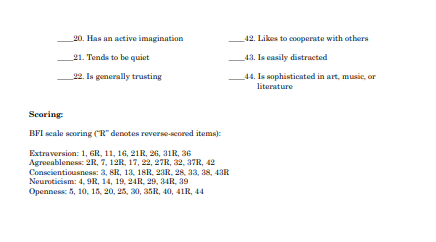Big Five Inventory (BFI)
Introduction
The Big Five Inventory (BFI) is a widely recognized psychological measurement tool used to assess personality traits based on the Five-Factor Model. This inventory evaluates an individual’s tendencies across five broad dimensions: openness, conscientiousness, extraversion, agreeableness, and neuroticism. It is extensively used in research, clinical settings, and organizational psychology for understanding personality dynamics and their impact on behavior.
1. What is the Big Five Inventory (BFI)?
The BFI is a self-report inventory designed to measure the Big Five personality traits. Developed by John, Donahue, and Kentle (1991), it consists of 44 short statements rated on a Likert scale. Each statement reflects one of the five factors, providing a comprehensive profile of an individual’s personality.
2. What is the Big Five Inventory (BFI) Used For?
The BFI is used in a variety of contexts, including:
- Psychological Research: To explore the relationship between personality traits and behavior.
- Clinical Settings: To understand personality factors contributing to mental health conditions.
- Organizational Psychology: For employee selection, team dynamics, and leadership assessment.
- Educational Settings: To study personality development and its impact on academic outcomes.
- Personal Development: Helping individuals gain insights into their personality traits for self-improvement.
3. What is the Procedure for Administering the Big Five Inventory (BFI)?
- Preparation:
- Ensure a quiet environment to avoid distractions.
- Provide clear instructions to participants.
- Administration:
- Participants complete the inventory by rating 44 statements on a Likert scale ranging from 1 (strongly disagree) to 5 (strongly agree).
- The process typically takes 5-10 minutes.
- Scoring:
- Responses are scored to generate a total score for each of the five factors.
- Higher scores indicate stronger tendencies in the respective traits.
- Interpretation:
- Results are interpreted based on normative data or study-specific benchmarks.
4. What are the Factor Names in the Big Five Inventory (BFI)?
The five factors assessed by the BFI, also known as the Five-Factor Model, provide a comprehensive framework for understanding personality. Each factor represents a broad domain of human behavior, allowing researchers to explore the nuanced interplay of traits that influence actions, decisions, and interpersonal interactions. These dimensions are:
- Openness to Experience: Creativity, imagination, and a preference for novelty.
- Conscientiousness: Organization, responsibility, and goal-oriented behavior.
- Extraversion: Sociability, energy, and assertiveness.
- Agreeableness: Compassion, trust, and cooperation.
- Neuroticism: Emotional instability, anxiety, and moodiness.
5. How are Factor Scores Calculated for the Big Five Inventory (BFI)?
Calculating factor scores for the Big Five Inventory (BFI) involves a systematic process to ensure accuracy and meaningful interpretation of results. This process highlights the nuanced contributions of individual responses to each of the five personality dimensions.
- Assign Points: Responses on the Likert scale (1-5) are assigned corresponding points.
- Reverse Scoring/facto items: Certain negatively worded items are reverse-scored (“R” denotes reverse-scored items).
- Extraversion: Items 1, 6R, 11, 16, 21R, 26, 31R, 36
- Agreeableness: Items 2R, 7, 12R, 17, 22, 27R, 32, 37R, 42
- Conscientiousness: Items 3, 8R, 13, 18R, 23R, 28, 33, 38, 43R
- Neuroticism: Items 4, 9R, 14, 19, 24R, 29, 34R, 39
- Openness: Items 5, 10, 15, 20, 25, 30, 35R, 40, 41R, 44
- Summation: Scores for each factor are summed to produce a total score.
- Normalization: Scores can be standardized or compared against normative data for interpretation.









